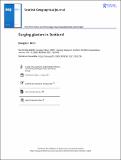Files in this item
Surging glaciers in Scotland
Item metadata
| dc.contributor.author | Benn, Douglas I. | |
| dc.date.accessioned | 2021-05-13T09:30:02Z | |
| dc.date.available | 2021-05-13T09:30:02Z | |
| dc.date.issued | 2021-05-11 | |
| dc.identifier | 273979169 | |
| dc.identifier | bedddb16-154f-4b7a-8958-8ae9ec4c449b | |
| dc.identifier | 85106054379 | |
| dc.identifier | 000649627400001 | |
| dc.identifier.citation | Benn , D I 2021 , ' Surging glaciers in Scotland ' , Scottish Geographical Journal , vol. Latest Articles . https://doi.org/10.1080/14702541.2021.1922738 | en |
| dc.identifier.issn | 1470-2541 | |
| dc.identifier.other | ORCID: /0000-0002-3604-0886/work/93894027 | |
| dc.identifier.uri | https://hdl.handle.net/10023/23173 | |
| dc.description | Help with data compilation and analysis was provided by Rebekah Kaufman with funding from the St Andrews University Undergraduate Research Assistant Scheme. | en |
| dc.description.abstract | Glacier surges are cyclic oscillations of velocity and mass resulting from internal dynamic instabilities. For surge-type glaciers, cycles of advance and retreat are decoupled from climate forcing, so it is important to consider the possibility that former glaciers may have been surge-type when making climatic inferences from their dimensions and chronologies. In this paper, climatic and glacier geometric data are used to show that Scotland was likely the location of a surge cluster during the Loch Lomond Stade (∼12.9–11.7 ka), with high probabilities of surging for outlets of the West Highland Icefield and the larger glaciers in the Inner Hebrides and Northern Highlands. Terrestrial and marine landforms consistent with surging occur in all of these areas, and it is proposed that surge-type glaciers existed on the Islands of Skye and Mull, in the Northern Highlands, and in a ‘surging arc’ along the western, southern and south-eastern margins of the West Highland Icefield. The possibility that surge-type glaciers were widespread in Scotland during the Loch Lomond Stade offers a fresh perspective on some long-standing issues, including the relationship between style of deglaciation and climate change, the climatic significance of glacial chronologies, palaeoclimatic reconstructions, and the interpretation of numerical model results. | |
| dc.format.extent | 4541410 | |
| dc.language.iso | eng | |
| dc.relation.ispartof | Scottish Geographical Journal | en |
| dc.subject | Glacial environments | en |
| dc.subject | Palaeoenvironment/quaternary studies | en |
| dc.subject | Polar environments | en |
| dc.subject | G Geography (General) | en |
| dc.subject | T-NDAS | en |
| dc.subject | SDG 13 - Climate Action | en |
| dc.subject | SDG 14 - Life Below Water | en |
| dc.subject.lcc | G1 | en |
| dc.title | Surging glaciers in Scotland | en |
| dc.type | Journal article | en |
| dc.contributor.institution | University of St Andrews. Environmental Change Research Group | en |
| dc.contributor.institution | University of St Andrews. Bell-Edwards Geographic Data Institute | en |
| dc.contributor.institution | University of St Andrews. School of Geography & Sustainable Development | en |
| dc.identifier.doi | https://doi.org/10.1080/14702541.2021.1922738 | |
| dc.description.status | Peer reviewed | en |
This item appears in the following Collection(s)
Items in the St Andrews Research Repository are protected by copyright, with all rights reserved, unless otherwise indicated.

